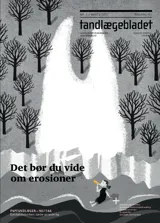Consensus report of the European Federation of Conservative Dentistry: Erosive tooth wear – diagnosis and management
En effektiv indsats af ET omfatter screening for tidlige tegn og evaluering af alle ætiologiske faktorer.
Konsensusrapport fra European Federation of Conservative Dentistry: erosioner – diagnose, forebyggelse og behandling
Formål
Som følge af øget fokus på erosive tandskader (ET) har European Federation of Conservative Dentistry (EFCD) anset ETW som et relevant emne til udarbejdelse af en konsensusrapport.
Materialer og metoder
Denne rapport er baseret på den foreliggende videnskabelige litteratur, en ekspertkonference og en godkendelse af generalforsamlingen for EFCD.
Resultater
ET er en kemisk-mekanisk proces, som resulterer i et kumulativt tab af hårdt tandvæv, der ikke skyldes bakterier. Hårdtvævsforandringen er kendetegnet ved tab af naturlig overflademorfologi og tændernes kontur. Et egnet indeks til klassifikation af ET er ”Basic Erosive wear examination” (BEWE). Ætiologien omfatter patientrelaterede faktorer som prædisposition over for erosion, refluks, opkastning, drikke- og spisevaner samt medicin og kosttilskud. Ernæringsmæssige faktorer relaterer sig til sammensætning af mad og drikkevarer, fx med lavt pH og høj bufferkapacitet (store risikofaktorer) og calciumkoncentrationen (større beskyttelsesfaktor). Arbejdsrelaterede faktorer omfatter eksponering for syrer eller dampe. Forebyggelse af ET sigter mod at reducere eller standse progressionen af læsionerne. Restaurerende behandling sigter mod at reducere symptomer i form af smerte og dentinoverfølsomhed eller genoprette æstetik og funktion, som bør anvendes i forbindelse med forebyggende strategier.
Konklusioner
En effektiv indsats af ET omfatter screening for tidlige tegn og evaluering af alle ætiologiske faktorer.
Klinisk relevans:
Erosive tooth wear is a clinical condition, which calls for the increased attention of the dental community and is a challenge for the cooperation with other medical specialities
Objective – Due to an increased focus on erosive tooth wear (ETW), the European Federation of Conservative Dentistry (EFCD) considered ETW as a relevant topic for generating this consensus report. Materials and methods – This report is based on a compilation of the scientific literature, an expert conference, and the approval by the General Assembly of EFCD.
Results – ETW is a chemical-mechanical process resulting in a cumulative loss of hard dental tissue not caused by bacteria, and it is characterized by loss of the natural surface morphology and contour of the teeth. A suitable index for classification of ETW is the basic erosive wear examination (BEWE). Regarding the etiology, patient-related factors include the predisposition to erosion, reflux, vomiting, drinking and eating habits, as well as medications and dietary supplements. Nutritional factors relate to the composition of foods and beverages, e.g., with low pH and high buffer capacity (major risk factors), and calcium concentration (major protective factor). Occupational factors are exposition of workers to acidic liquids or vapors. Preventive management of ETW aims at reducing or stopping the progression of the lesions. Restorative management aims at reducing symptoms of pain and dentine hypersensitivity, or to restore esthetic and function, but it should only be used in conjunction with preventive strategies.
Conclusions – Effective management of ETW includes screening for early signs of ETW and evaluating all etiological factors.


